Related Research Articles
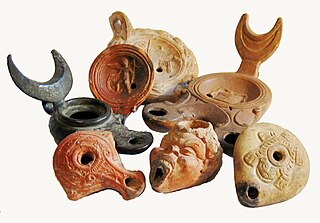
An oil lamp is a lamp used to produce light continuously for a period of time using an oil-based fuel source. The use of oil lamps began thousands of years ago and continues to this day, although their use is less common in modern times. They work in the same way as a candle but with fuel that is liquid at room temperature, so that a container for the oil is required. A textile wick drops down into the oil, and is lit at the end, burning the oil as it is drawn up the wick.

Émile Gallé was a French artist and designer who worked in glass, and is considered to be one of the major innovators in the French Art Nouveau movement. He was noted for his designs of Art Nouveau glass art and Art Nouveau furniture, and was a founder of the École de Nancy or Nancy School, a movement of design in the city of Nancy, France.

Glassblowing is a glassforming technique that involves inflating molten glass into a bubble with the aid of a blowpipe. A person who blows glass is called a glassblower, glassmith, or gaffer. A lampworker manipulates glass with the use of a torch on a smaller scale, such as in producing precision laboratory glassware out of borosilicate glass.
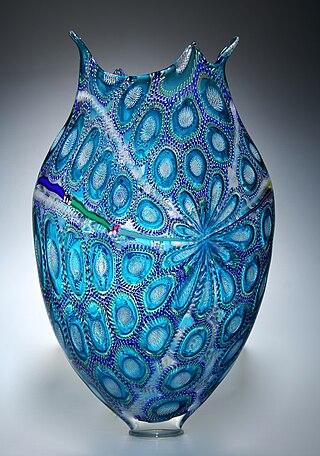
Studio glass is the modern use of glass as an artistic medium to produce sculptures or three-dimensional artworks in the fine arts. The glass objects created are intended to make a sculptural or decorative statement, and typically serve no useful function. Though usage varies, the term is properly restricted to glass made as art in small workshops, typically with the personal involvement of the artist who designed the piece. This is in contrast to art glass, made by craftsmen in factories, and glass art, covering the whole range of glass with artistic interest made throughout history. Both art glass and studio glass originate in the 19th century, and the terms compare with studio pottery and art pottery, but in glass the term "studio glass" is mostly used for work made in the period beginning in the 1960s with a major revival in interest in artistic glassmaking.

A chandelier is an ornamental lighting device, typically with spreading branched supports for multiple lights, designed to be hung from the ceiling. Chandeliers are often ornate, and they were originally designed to hold candles, but now incandescent light bulbs are commonly used, as well as fluorescent lamps and LEDs.

Lampworking is a type of glasswork in which a torch or lamp is used to melt the glass. Once in a molten state, the glass is formed by blowing and shaping with tools and hand movements. It is also known as flameworking or torchworking, as the modern practice no longer uses oil-fueled lamps. Although lack of a precise definition for lampworking makes it difficult to determine when this technique was first developed, the earliest verifiable lampworked glass is probably a collection of beads thought to date to the fifth century BCE. Lampworking became widely practiced in Murano, Italy in the 14th century. As early as the 17th century, itinerant glassworkers demonstrated lampworking to the public. In the mid-19th century lampwork technique was extended to the production of paperweights, primarily in France, where it became a popular art form, still collected today. Lampworking differs from glassblowing in that glassblowing uses a furnace as the primary heat source, although torches are also used.

The Roman-Germanic Museum is an archaeological museum in Cologne, Germany. It has a large collection of Roman artifacts from the Roman settlement of Colonia Claudia Ara Agrippinensium, on which modern Cologne is built. The museum protects the original site of a Roman town villa, from which a large Dionysus mosaic remains in its original place in the basement, and the related Roman Road just outside. In this respect the museum is an archaeological site.

The Great Saint Martin Church is a Romanesque Catholic church in Cologne, Germany. Its foundations rest on remnants of a Roman chapel, built on what was then an island in the Rhine. The church was later transformed into a Benedictine monastery. The current buildings, including a soaring crossing tower that is a landmark of Cologne's Old Town, were erected between 1150-1250. The architecture of its eastern end forms a triconch or trefoil plan, consisting of three apses around the crossing, similar to that at St. Maria im Kapitol. The church was badly damaged in World War II; restoration work was completed in 1985.

A cage cup, also vas diatretum, plural diatreta, or "reticulated cup" is a type of luxury late Roman glass vessel, found from roughly the 4th century, and "the pinnacle of Roman achievements in glass-making". Diatreta consist of an inner beaker and an outer cage or shell of decoration that stands out from the body of the cup, to which it is attached by short stems or shanks. About fifty cups or, more often, fragments have survived, and there are only a few in near-complete condition. Most have a cage with circular geometrical patterns, often with an "inscription", or phrase in letters above the reticulated area as well. Some have a flange, or zone of projecting open-cut moulding, above the lower patterns and below the lettering.

The Lycurgus Cup is a Roman glass 4th-century cage cup made of a dichroic glass, which shows a different colour depending on whether or not light is passing through it: red when lit from behind and green when lit from in front. It is the only complete Roman glass object made from this type of glass, and the one exhibiting the most impressive change in colour; it has been described as "the most spectacular glass of the period, fittingly decorated, which we know to have existed".
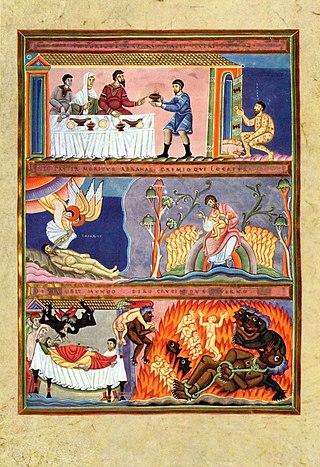
The Codex Aureus of Echternach is an illuminated Gospel Book, created in the approximate period 1030–1050, with a re-used front cover from around the 980s. It is now in the Germanisches Nationalmuseum in Nuremberg.

Roman glass objects have been recovered across the Roman Empire in domestic, industrial and funerary contexts. Glass was used primarily for the production of vessels, although mosaic tiles and window glass were also produced. Roman glass production developed from Hellenistic technical traditions, initially concentrating on the production of intensely coloured cast glass vessels.

A rummer was a type of large drinking glass studded with prunts to ensure a safe grip, popular mainly in the Rhineland and the Netherlands from the 15th through the 17th century. Rummers lacked the flared bowl of the Berkemeyer and had much thinner walls. The hollow base was built up by coiling strands of molten glass around a conical core. Römers were quite distinct from the Berkemeyers, but both types evolved from the German "cabbage stalk" glasses which were cylindrical with prunts. Römers are usually green in colour and with Berkemeyers were sometimes engraved with images and inscriptions.
A glossary of terms used in glass art

Pottery was produced in enormous quantities in ancient Rome, mostly for utilitarian purposes. It is found all over the former Roman Empire and beyond. Monte Testaccio is a huge waste mound in Rome made almost entirely of broken amphorae used for transporting and storing liquids and other products – in this case probably mostly Spanish olive oil, which was landed nearby, and was the main fuel for lighting, as well as its use in the kitchen and washing in the baths.
Early American molded glass refers to glass functional and decorative objects, such as bottles and dishware, that were manufactured in the United States in the 19th century. The objects were produced by blowing molten glass into a mold, thereby causing the glass to assume the shape and pattern design of the mold. When a plunger rather than blowing is used, as became usual later, the glass is technically called pressed glass. Common blown molded tableware items bearing designs include salt dishes, sugar bowls, creamers, celery stands, decanters, and drinking glasses.
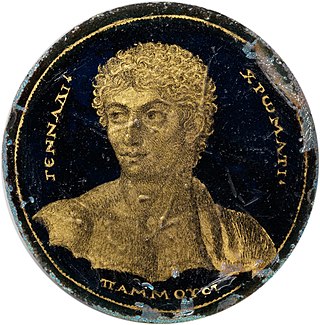
Gold glass or gold sandwich glass is a luxury form of glass where a decorative design in gold leaf is fused between two layers of glass. First found in Hellenistic Greece, it is especially characteristic of the Roman glass of the Late Empire in the 3rd and 4th century AD, where the gold decorated roundels of cups and other vessels were often cut out of the piece they had originally decorated and cemented to the walls of the catacombs of Rome as grave markers for the small recesses where bodies were buried. About 500 pieces of gold glass used in this way have been recovered. Complete vessels are far rarer. Many show religious imagery from Christianity, traditional Greco-Roman religion and its various cultic developments, and in a few examples Judaism. Others show portraits of their owners, and the finest are "among the most vivid portraits to survive from Early Christian times. They stare out at us with an extraordinary stern and melancholy intensity". From the 1st century AD the technique was also used for the gold colour in mosaics.

The Rheinische Landesmuseum Trier is an archaeological museum in Trier, Germany. The collection stretches from prehistory through the Roman period, the Middle Ages to the Baroque era with a strong emphasis on the Roman past of Augusta Treverorum, Germany's oldest city. Its collections of (local) Roman sculptures, Roman mosaics and frescos are among the best in Germany.
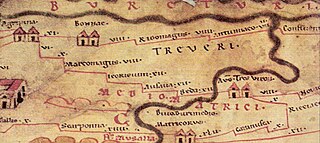
The Roman road from Trier to Cologne is part of the Via Agrippa, a Roman era long distance road network, that began at Lyon. The section from Augusta Treverorum (Trier) to the CCAA (Cologne), the capital of the Roman province of Germania Inferior, had a length of 66 Roman leagues. It is described in the Itinerarium Antonini, the itinerarium by Emperor Caracalla (198–217), which was revised in the 3rd century, and portrayed in the Tabula Peutingeriana or Peutinger Table, the Roman map of the world discovered in the 16th century, which shows the Roman road network of the 4th century.

Enamelled glass or painted glass is glass which has been decorated with vitreous enamel and then fired to fuse the glasses. It can produce brilliant and long-lasting colours, and be translucent or opaque. Unlike most methods of decorating glass, it allows painting using several colours, and along with glass engraving, has historically been the main technique used to create the full range of image types on glass.
References
- ↑ Josef Welzel, Das Diatretglas aus Szekszárd in Ungarn, Journal of Glass Studies 41, 1999, p. 153
- ↑ Cologne conchylia cup
- Stern, E.M. Roman, Byzantine, and Early Medieval Glass. 10 BCE-700CE. Hatje Cantz Publishers, 2001, p.143. Cat. N. 68–69. About the type, see O. Doppelfeld, “Der neue Kölner Konchylienbecher” in Festschrift Haberey 1976, pp. 23–28. Fremersdorf, F. Römisches Geformtes Glas in Köln, Denkmäler des römischen Köln, vol.6 (Cologne, 1961), p. 27 for its Roman origin, which is also discussed by Stern (Stern 2001, p. 141–142).
- Harden, D. B. Glass of the Caesars. Exh. cat., organized by: The Corning Museum of Glass, Corning, N. Y., The British Museum, London, Römisch-Germanisches Museum, Cologne; Olivetti, Milan, 1987.